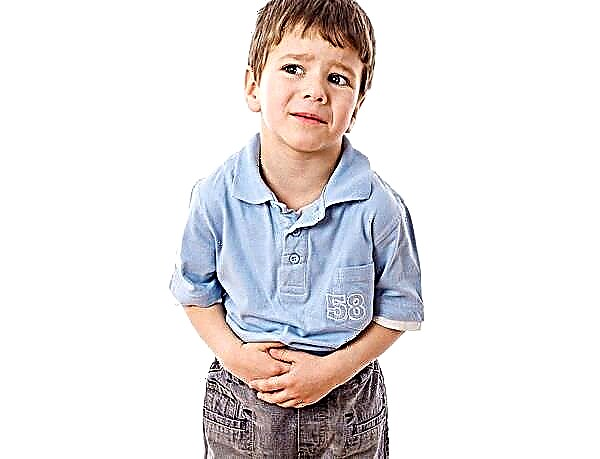
Children's bronchitis is a common disease. Many parents recognize him by almost the first symptoms - wheezing in the bronchi. And all because there is, perhaps, not a single child who has never had bronchitis in his life. With this ailment, as you know, treatment must be quick and accurate so that unwanted complications do not appear. Many mothers and fathers ask if it is possible to do with folk remedies for bronchitis. This is what we will try to understand in this article.
What is it, symptoms and signs
Bronchitis is an inflammation of the lining of the bronchi, both the mucous membrane and the entire bronchial wall. In children, it can appear in two ways - both as a separate ailment (primary), and as an echo or complication of another past disease (secondary).

As a result of inflammation, the ability of the bronchi to produce and promptly remove a special secret, which initially serves to protect the respiratory system from the penetration of viruses and other foreign "guests", is disrupted. During illness, more secretion is formed, and if its output to the outside (in the form of sputum as a result of expectoration) is impaired, this is fraught with serious consequences, such as pneumonia.


Bronchitis in children is acute, recurrent (recurrent) and chronic. It can be attributed to one category or another, knowing how long the baby has been suffering from.
Acute bronchitis most often appears as a complication of acute respiratory infections, acute respiratory viral infections and influenza, as well as some other infectious diseases, that is, it is caused by viruses. Bacterial bronchitis is very rare. If you treat it correctly and in a timely manner, the prognosis is always positive. For 3-4 weeks, there will be no trace of the disease.
If you treat the wrong and wrong, or do not treat the acute form of the disease at all, then it will turn into a recurrent one, and then into a chronic one. Such bronchitis therapy is much more difficult.
Depending on how the inflammation proceeds, the ailment can be catarrhal or purulent. According to changes in breathing, the ailment can also be classified as obstructive.

In acute bronchitis, the child will have a "low cough", chest. Against the background of ARVI, the temperature rises, a runny nose appears. For the first two to three days, the child will suffer from a dry, unproductive cough reflex. And then copious sputum, sometimes with pus, will begin to leave. If the ailment is accompanied by shortness of breath, then the child will be diagnosed with obstructive bronchitis.
With chronic bronchitis, the cough plagues the child for several months in a row. As a rule, it intensifies in the morning and subsides somewhat in the evening. However, the reflex does not bring much relief, since a small amount of phlegm is secreted, although the cough is moist. Children with allergies suffer more from the chronic form of the disease.
Not every child who has a viral infection or has allergies develops bronchitis.
In many ways, the peculiarities of the state of the baby's immune system, as well as the presence or absence of factors that are considered to be predisposing to bronchitis, play a role:
- Air pollution (dust, smoke, fumes, gases).
- Air is too dry or too humid.
- Unfavorable ecological situation.

- Violation of blood flow associated with the child's pathologies of the heart and blood vessels.
- Certain chronic diseases of the ear, throat and nose (tonsillitis, adenoids).
- Congenital respiratory problems.
- Chemical irritants (for example, tobacco smoke if someone smokes in the house and the child is forced to inhale the smoke).


What is the danger?
Bronchitis can get complicated and become bronchopneumonia. This is a rather dangerous disease, in which, against the background of reduced immunity, a bacterial secondary is added to a viral infection. Another unpleasant possible complication is pneumonia (pneumonia). Long-term chronic bronchitis can develop into obstructive pulmonary disease. In the most severe cases, bronchial asthma, pulmonary emphysema and cardiopulmonary insufficiency develop.
Treatment methods
Since most cases of childhood bronchitis are viral in nature, antibiotics are not effective for this disease. But a good result is the use of anti-inflammatory drugs ("Ibuprofen", etc.). Doctors willingly allow patients to treat this disease with alternative medicine. Moreover, both in addition to drug treatment, and as an independent therapy. First of all, this is a large number of special concoctions, teas and infusions for thinning phlegm.
If the sputum does not have pus impurities, rubbing and warming compresses can be done. For children of any age, vibration (drainage) massage will be useful, we will talk about it below.


When is it impossible to do with folk methods?
Despite the positive attitude of doctors towards traditional medicine recipes in the treatment of bronchitis, there are conditions that require exclusively drug therapy. These are bacterial bronchitis, which are severe, sometimes requiring hospitalization. If a child develops a secondary bacterial infection, the doctor will also not allow the use of folk remedies, with the exception of vibration massage.
Another "contraindication" for alternative medicine is the presence of impurities of pus and blood in the expectorated sputum. Chronic bronchitis is not always treatable with home remedies.
Folk remedies
Beverages
It is best to brew teas with raspberries, currants for a child, make fruit drinks from frozen or fresh berries, pediatricians recommend drinking more compotes and decoctions for this disease. However, the use of herbal decoctions and infusions should be preliminarily agreed with a doctor in order to reduce the risk of an allergic reaction to plant substances and essential oils. At home, you can brew simple but effective health drinks.
- A decoction of plantain helps well, for the preparation of which you need to take a tablespoon of crushed dry leaves (not sold in a pharmacy), and brew 200 ml of boiling water. Infants are dosed with a decoction with teaspoons, older children can be given a quarter of a glass at a time.

- The removal of sputum and the reduction of the inflammatory process is promoted by radish juice. For this, the root crop is cleaned, cut into small pieces and sprinkled with sugar. It is necessary to insist the product in a closed container for about 12 hours, after which the resulting juice should be given a teaspoon several times a day. Radish and sugar are contraindicated for infants. And for a child after 3 years, honey can be put instead of sugar, if he does not have an allergic reaction.

- A good drink can be made from chamomile and raspberry leaves. You need to take a tablespoon of herbal raw materials and pour half a liter of boiled water. Insist in a water bath for about 10 minutes, and then cool, strain and give the child a quarter of a glass 3 times a day.


Onions and garlic, lemon, figs, horseradish, mint, cinnamon, milk and ginger are considered the best "helpers" for parents in the treatment of childhood bronchitis.
Rubbing and wrapping. Children from 3 years old can rub their chest and back with warm camphor oil or fir oil. Special wraps can be done with ordinary sunflower oil or sea buckthorn oil. To do this, heat the oil in a water bath, soak a towel in it, wrap the child's torso for several hours.

The most famous rubbing for bronchitis is rubbing with badger fat. The child's chest and back are abundantly lubricated with this agent, and then the patient is covered with a warm blanket. It is strictly forbidden to do warming rubbing and wrapping at elevated body temperature, as well as in the presence of pus and blood in the sputum.


Compresses
Sputum removal will become easier and faster if a curd compress is applied to the baby's chest all night long. To prepare it, you need 300 grams of granular cottage cheese, fold it into cheesecloth, give it a rectangular shape. Apply the resulting layer to the chest, making sure that there are no wounds or abrasions on the skin. You can use cling film as an intermediate layer. According to parents, 3-4 days are enough to notice the effect of curd compresses.
They make warm in the same way potato compress which is imposed for 1-2 hours in the daytime.
In no case should children do compresses based on alcohol and vinegar. These substances are highly irritating to the skin, and inhalation of vapors complicates the course of the bronchitis itself.

Massage
This is a great way to relieve a child of stagnation of phlegm in the bronchi and speed up recovery. The baby is taken in his arms and gently tapped with his fingertips on the back, and then on the breast in the region of the bronchi and lungs.

Older children are placed across the knees of an adult, so that the head is a level above the priests. They tap with their fingertips and make circular movements along the back in the region of the bronchi. Then they ask the child to stand up abruptly and clear his throat.

Tapping (vibration) movements massage the area of the ribs on the sides of the sternum in a standing position. It is important to repeat each technique at least 10-15 times in one session.
These simple actions, which any mom and even dad can do on their own, help to avoid stagnation and drying out of mucus in the bronchi.

Tips
When treating bronchitis, especially an acute form, it is very important to frequently and abundantly water the child (from 2 to 4 liters per day). The drink should be warm. This will help drain bronchial secretions from the inflamed respiratory system.
It is imperative to humidify the air in the room where the child with bronchitis is. To do this, you can use special devices - humidifiers, or simply hang out wet towels and sheets more often and make sure that they do not dry out. It is especially important to create sufficiently humidified air in winter, at the height of the heating season. The humidity level should be 50-70%.

With bronchitis, children sweat more often and profusely. It is important to make sure that the baby is dressed for the weather, not warmer. In case of heavy sweating, the child should be rinsed under the shower and changed into dry clothes.

As soon as the acute phase of the disease is left behind, the temperature has returned to normal values, allow the child to lie in bed less during the daytime. To cough faster, at this stage you need to move a lot, walk in the fresh air, play actively.




